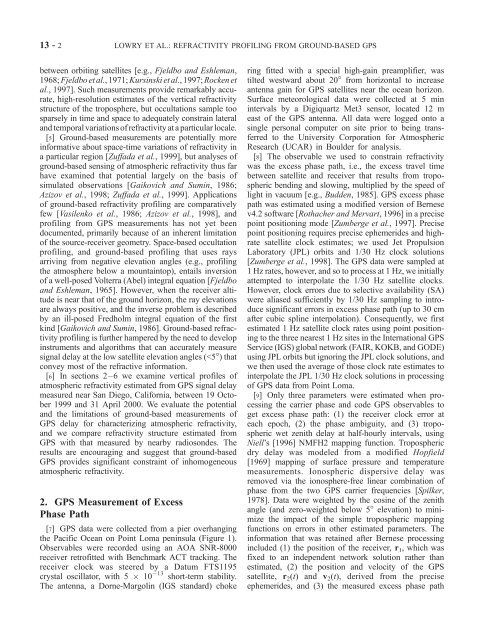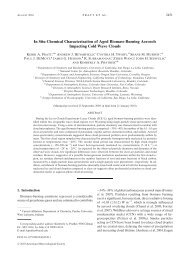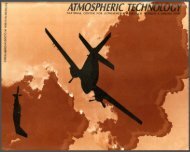Vertical profiling of atmospheric refractivity from ground-based GPS
Vertical profiling of atmospheric refractivity from ground-based GPS
Vertical profiling of atmospheric refractivity from ground-based GPS
Create successful ePaper yourself
Turn your PDF publications into a flip-book with our unique Google optimized e-Paper software.
13 - 2 LOWRY ET AL.: REFRACTIVITY PROFILING FROM GROUND-BASED <strong>GPS</strong><br />
between orbiting satellites [e.g., Fjeldbo and Eshleman,<br />
1968; Fjeldbo et al., 1971; Kursinski et al., 1997; Rocken et<br />
al., 1997]. Such measurements provide remarkably accurate,<br />
high-resolution estimates <strong>of</strong> the vertical <strong>refractivity</strong><br />
structure <strong>of</strong> the troposphere, but occultations sample too<br />
sparsely in time and space to adequately constrain lateral<br />
and temporal variations <strong>of</strong> <strong>refractivity</strong> at a particular locale.<br />
[5] Ground-<strong>based</strong> measurements are potentially more<br />
informative about space-time variations <strong>of</strong> <strong>refractivity</strong> in<br />
a particular region [Zuffada et al., 1999], but analyses <strong>of</strong><br />
<strong>ground</strong>-<strong>based</strong> sensing <strong>of</strong> <strong>atmospheric</strong> <strong>refractivity</strong> thus far<br />
have examined that potential largely on the basis <strong>of</strong><br />
simulated observations [Gaikovich and Sumin, 1986;<br />
Azizov et al., 1998; Zuffada et al., 1999]. Applications<br />
<strong>of</strong> <strong>ground</strong>-<strong>based</strong> <strong>refractivity</strong> <strong>pr<strong>of</strong>iling</strong> are comparatively<br />
few [Vasilenko et al., 1986; Azizov et al., 1998], and<br />
<strong>pr<strong>of</strong>iling</strong> <strong>from</strong> <strong>GPS</strong> measurements has not yet been<br />
documented, primarily because <strong>of</strong> an inherent limitation<br />
<strong>of</strong> the source-receiver geometry. Space-<strong>based</strong> occultation<br />
<strong>pr<strong>of</strong>iling</strong>, and <strong>ground</strong>-<strong>based</strong> <strong>pr<strong>of</strong>iling</strong> that uses rays<br />
arriving <strong>from</strong> negative elevation angles (e.g., <strong>pr<strong>of</strong>iling</strong><br />
the atmosphere below a mountaintop), entails inversion<br />
<strong>of</strong> a well-posed Volterra (Abel) integral equation [Fjeldbo<br />
and Eshleman, 1965]. However, when the receiver altitude<br />
is near that <strong>of</strong> the <strong>ground</strong> horizon, the ray elevations<br />
are always positive, and the inverse problem is described<br />
by an ill-posed Fredholm integral equation <strong>of</strong> the first<br />
kind [Gaikovich and Sumin, 1986]. Ground-<strong>based</strong> <strong>refractivity</strong><br />
<strong>pr<strong>of</strong>iling</strong> is further hampered by the need to develop<br />
instruments and algorithms that can accurately measure<br />
signal delay at the low satellite elevation angles (






